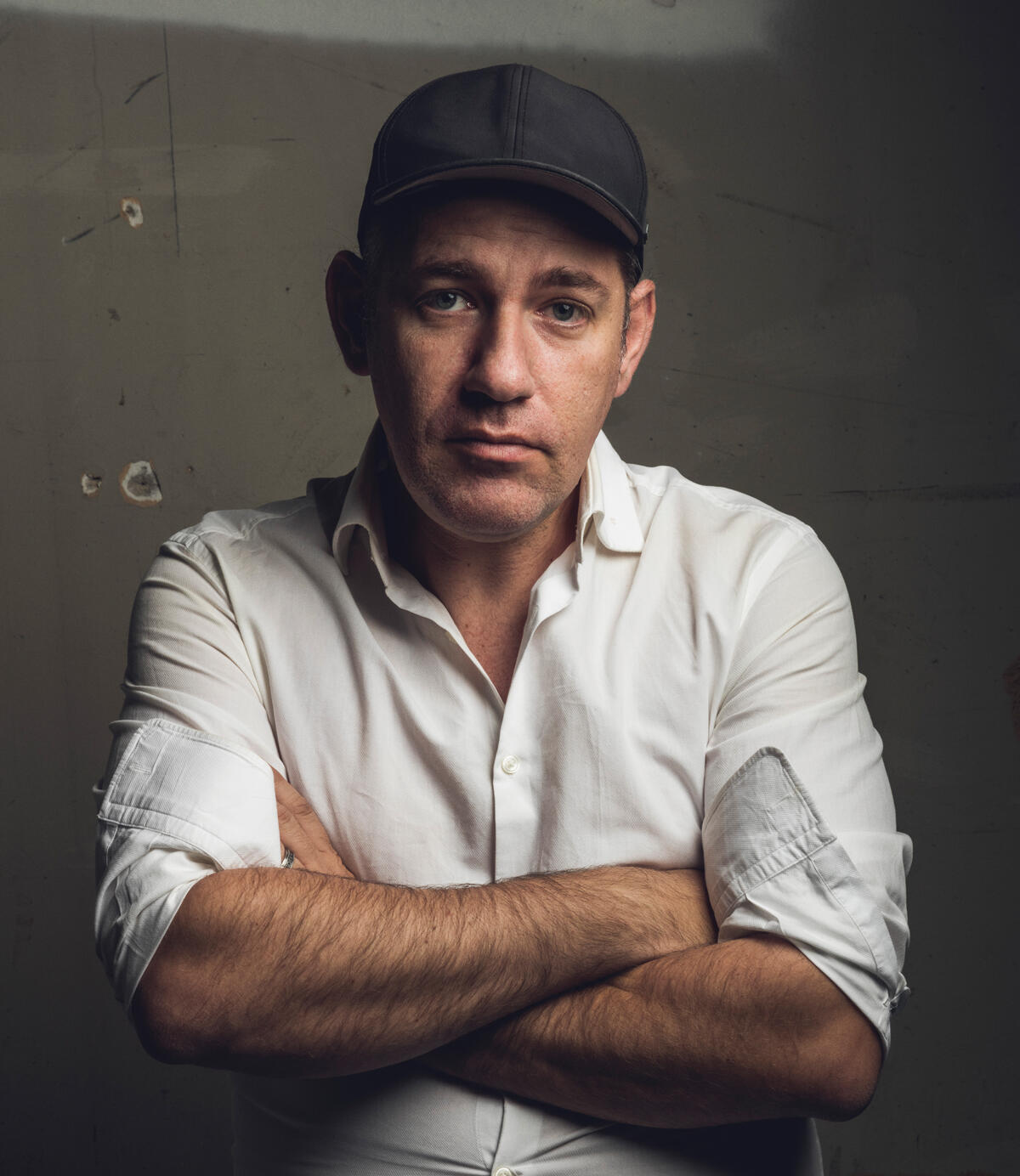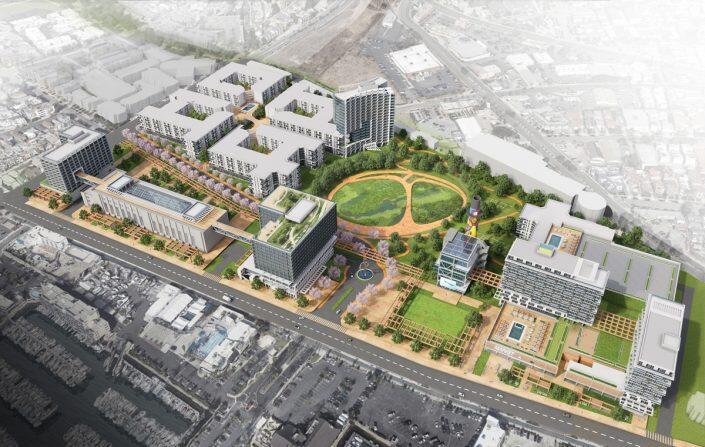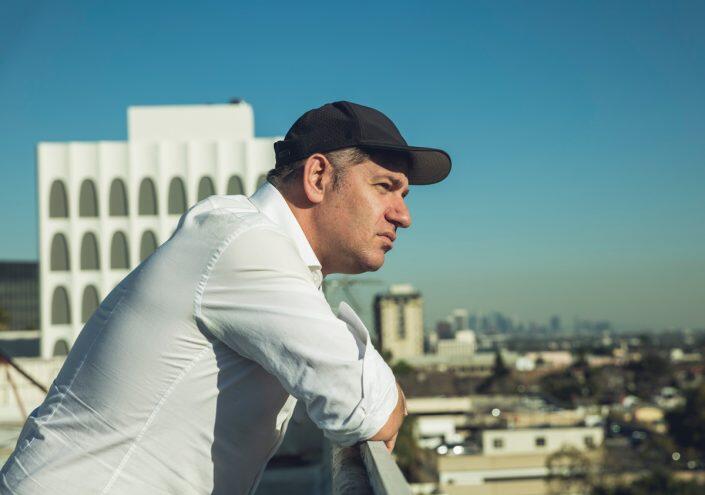Meet the developer giving California NIMBYs nightmares
Leo Pustilnikov wants to bring 2,700 units to a reviled Redondo Beach power plant site. The city's trying everything to stop him

Even from a half mile away, the property was arresting. It was a sunny November morning in Redondo Beach, and the sweeping downhill view of the Pacific coastline was crowded out by towering white smokestacks and an imposing wall of steel. The sight was jarring, as if a block-wide slice of industrial Detroit or Pittsburgh had been dropped onto the coast of Southern California.
A few minutes later, a sleepy-looking guy in jeans and a cockeyed baseball cap stepped out of a black luxury sedan and into the power plant’s empty parking lot. It was Leo Pustilnikov, the 37-year-old owner of the place: For the next half hour, alongside a plant contractor who seemed pulled from central casting (scruffy beard, blue overalls), he strolled outside amid the site’s collection of structures and sprawling concrete, passing high-voltage signs and several small ponds.
Inside the facility’s main building, in a cavernous room that had once served as the industrial backdrop for a Britney Spears video, a 150-ton bridge crane was gliding across the ceiling. Pustilnikov, who had traded the cap for a hard hat, pulled out his phone and quietly started filming. “Sorry, I geeked out,” he said.
The site’s immense redevelopment potential was already obvious, but at one point, as if to emphasize the fact, he stepped into a small third-floor office, where a western-facing window opened onto a near-panoramic ocean view. “Are you doing apartments or condos?” the contractor asked Pustilnikov.
“Apartments.”
“How many?”
“Two thousand six hundred.”
“Holy shit.”
Pustilnikov closed on the power plant site in 2020, after Redondo Beach had battled for years over its fate, and his redevelopment plan, which he once described as a Barcelona-like commercial and residential village, ranks among the most ambitious projects in California. The proposal has turned the low-key Pustilnikov into a lightning rod, with his development fight consuming the town and spilling into the national news. Last summer, after Pustilnikov decided to pursue the project using builder’s remedy — the controversial legal provision that can allow developers to bypass local zoning — it also established him as a central player in one of the biggest housing stories to sweep the state in decades.
“Leo is the perfect kind of character to push the boundaries on what’s possible,” said Rafa Sonnenfeld, policy director at pro-housing nonprofit YIMBY Law. “He has the resources, and I guess more importantly the attitude, and he’s willing to take risks that a lot of people aren’t.”
“He’s the right sort of crazy,” Sonnenfeld added.
If Pustilnikov, who is engaged in multiple court battles, is successful, his Redondo project will help set a precedent for builder’s remedy, a provision that so far remains legally untested. With over 500 units set aside for low-income tenants, it would also rank among the largest affordable housing developments ever built in California. Yet both his supporters and opponents argue there’s even more at stake.
“I think Leo represents the future,” said Fred Bruning, a developer who’s battled for years over a different Redondo Beach waterfront project. “Bill Brand” — the city’s mayor — “represents segregation.”
Live wire
In 2016, when CBRE put out a marketing blitz for the 50-acre power plant site, Carlos Vigon, the listing broker, knew the complexity would necessitate a special buyer. The site generated interest from the typical cast of institutional developers, private equity firms, ultra-wealthy Americans and foreigners, “this parade of guys in their loafers and their starched shirts,” as Vigon put it, “coming in to do the dog-and-pony show.”
Then Pustilnikov walked into Vigon’s office, casually dressed, with a nonchalance that reminded the broker of a Silicon Valley techie. “OK,” he thought, “this may be our guy.”
Pustilnikov was in his early 30s at the time but had already quietly established himself as one of L.A.’s savviest — and most risk-tolerant — dealmakers. He also had an immigrant’s innate hustle. He was born in Odessa, in what is now Ukraine, as the only child of a shoemaker father and property manager mother, and arrived in L.A. as a 4-year-old, part of the exodus of Jews fleeing the tide of antisemitism that was rising with the collapse of the Soviet Union.
The married father of four recalls a challenging American childhood, with memories of recycling cans and weekends spent mopping an uncle’s false teeth factory. He was still in high school when he broke into real estate, using his savings and a loan in his parents’ name to buy his grandparents a condo in the family’s North Hollywood building. When his grandparents decided not to move in, Pustilnikov renovated it and sold at a profit, then used the funds to buy more property after the 2008 crash.
He graduated from multifamily sites to condos and more ambitious reuse projects, partnering with Izek Shomof, an Israeli émigré who’s been called a “godfather” of Downtown L.A.’s revitalization, on a plan to transform a historic 1.8 million-square-foot Sears building. He’s also teamed up with Shomof on purchases of the famed Rialto Theatre in South Pasadena and the Alexandria Hotel in DTLA, which the developers have since turned into affordable housing, and on multiple deals with Ely Dromy, another L.A. developer.
“Slowly but surely,” Pustilnikov said of his portfolio, “it grew and grew.”

Working out of cluttered digs in Beverly Hills, he estimates he’s completed more than 100 deals over the past decade, worth more than $1 billion — numbers that place him among the most prolific lone-wolf real estate investors anywhere.
“I think he would deny this, but I think he’s a deal junkie,” one of Pustilnikov’s partners said. “It’s almost like a game, and he loves to win.”
“Part of me is probably a deal junkie,” Pustilnikov said.
He makes no bones about expressing grievances: Asked about one tenant case against him in New York from 2018, he offered that it hit the press because the attorney is “a piece of shit.” (The attorney said the case was settled amicably.)
Yet in person Pustilnikov comes across as unpretentious and open, with a dry sense of humor. He can project weariness — “if there were a tax holiday, I assure you I’d sell everything and retire,” he said once — but is also clearly driven.
“I love him,” said Steve Aspel, a former mayor of Redondo Beach. “He’s got courage, and he’s actually one of the nicest guys you’re ever going to meet.”
Pustilnikov has made a career out of hunting for properties that are located in tony L.A. submarkets, such as Santa Monica and Beverly Hills, but saddled with challenges.
“His deals typically have hair on them,” said the same partner. “He sees things that others don’t see very easily, and he’s willing to take risks that others aren’t.”
But not even Pustilnikov could anticipate what Redondo Beach would throw at him.
Beachside brawl
Several years ago, Bruning, who heads development firm CenterCal Properties, approached Brand, who had recently been elected mayor, and asked if he wanted to take a stroll to discuss Bruning’s project plans.
Brand sharply declined. “Fred,” Bruning recalled the politician saying, “this is war.”
An early California resort town, Redondo is still whiter and wealthier than most of L.A. County, with a population of around 70,000 and a median home sale price of $1.3 million. And for years, it’s been consumed by a local development battle.
Most of it has centered on the site now owned by Pustilnikov. In the early 20th century, it hosted a steam-powered operation; in the 1940s, to power a booming Southern California, SoCal Edison built the existing natural gas-powered, seawater-cooled facility, and later sold it to Virginia-based AES. But for decades, it’s been reviled by residents, especially as newer plants have rendered it less essential and the state has repeatedly delayed a final closure.
The debate over what to actually do with it has nearly torn the town apart. In the early 2000s, AES, reading the local sentiment, backed a $1 billion plan, called Heart of the City, to slash the plant’s size by two-thirds and remake a chunk of the city’s waterfront into a “downtown-style” district with restaurants, offices, hotels and up to 3,000 housing units. But the plan unleashed a NIMBY army that blanketed the town with fliers and rallied about density and ocean views.
“This is our last stand,” one resident told the L.A. Times. In fact, it was only a teaser: Years later, buoyed by the successful opposition campaign, anti-density advocates led a successful push to stymie new projects by changing the city charter to require a public vote on major zoning changes. In 2013, the same group was narrowly defeated on a measure that would have rezoned most of the site for open space.
In 2015, AES and city officials worked out what they billed as a compromise, a more modest redevelopment with 600 apartments. If the rezoning measure failed, an AES executive warned, the firm’s only option would be to build a whole new power plant facility.
Redondo voters rejected it.
“I am stunned, actually,” Eric Pendergraft, the AES executive, told a reporter the night the vote came in. “I thought it was going to be close, but [that] at the end of the day people would vote for progress.”
All along, two men have helmed the anti-development fight: Brand, a fiery LAX crew chief, and Jim Light, an Air Force veteran who is president of the nonprofit South Bay Parkland Conservancy. The group was founded two decades ago with a mission to shut the plant and secure the land for a park, and that’s still the slow-growthers’ priority, Light said in a recent interview. He also denied that the decades-long fight was about NIMBYism, arguing that the city’s housing density is actually high.
“I think that’s a convenient term for them to demonize people,” he said, “but if you look at Redondo’s history that’s not true.”
The advocates have remade Redondo Beach politics: After snagging a City Council seat in 2009 and the mayorship in 2017, Brand, who did not respond to interview requests, has also emerged as a leader in even bigger anti-development fights against the state.
And what started as a push for park space has morphed into something unquestionably darker. Brand and a core group of allies, who one resident described as “cult-like,” are unapologetic about their all-out approach to stopping projects, and Brand is often crude: In emails to allies that were later exposed by the L.A. Times, the mayor mocked one female council member’s weight and referenced an editorial that would “ram it up Aspel’s cancerous ass.” (Aspel had been diagnosed with colon cancer.) He has also cited a need for “Trump-type slogans” that would “feed people’s anger and fear with clever sound bites.”
And it’s not just words. During the CenterCal fight, Bruning’s tires were slashed in Redondo Beach four times, he said, and drones were hovering over his house. Project supporters were deluged with insults and hate mail, including one council member who opponents branded as “CenterCal’s whore.” Residents openly fretted that the new housing would bring in “those people” from nearby L.A. County cities or even “Black and Mexican gangs.”
The racism and attacks, Bruning said, amounted to the saddest moment of his career. “The best way I can put it is that Bill Brand and his team want Redondo Beach to be Mayberry,” he said, referring to the fictional town in the ’60s sitcom “The Andy Griffith Show.” “Completely vanilla, no changes.”
But Redondo’s anti-growth crusaders did not anticipate Leo Pustilnikov.
Turning heel
After months of negotiations, Pustilnikov, partnering with Dromy, closed on the site in 2020 for around $150 million, $80 million less than the price AES had paid two decades earlier. The irony, Vigon pointed out, was that the years long fight to secure the land for park space had ended up facilitating the sale: Without all the complications, the broker estimated, it could have fetched $1 billion.
“This wasn’t just the real estate land transaction of the century in the South Bay,” Vigon commented at the time, “but the deal of the century for the buyer.”
The buyer started out on good terms with Redondo’s slow-growth crowd. Pustilnikov met several times with representatives from the state, including those from the powerful California Coastal Commission. He also met with Light, who came away from one meeting cautiously optimistic. So did Brand.
“Finally,” the new mayor said that fall, “we have a monumental opportunity to work with a private developer who’s focused on restoring wetlands and open space.”
The relationship, however, quickly soured. In early 2019, before the deal had closed, Pustilnikov seemed to agree to a plan to sell about half the site to the city: At the time, Redondo officials were consulting with the architecture firm behind Chicago’s Millennium Park, and when they applied for funding, Pustinikov, who had always insisted on leaving much of the site for open space, signed a letter indicating his intent to sell the city up to 25 acres at $2 million per acre.
“And then all of a sudden he reneged,” said Light.
Pustilnikov approached the City Council with a different proposal: Instead of selling a chunk of the site, he would retain ownership but make 21 acres available to the city at no cost. In exchange, he wanted officials’ support in keeping the plant open longer in order to work on development plans for the remaining portion, which would also allow him to continue collecting rent.

Pustilnikov denies reneging: There had never been a definitive agreement to sell a portion to the city, he said, and he had stopped cooperating with Redondo officials because they screwed him on another pending commercial deal.
“I just don’t trust these people,” he remembers thinking.
The failed city park deal made Pustilnikov a villain. Opponents openly blasted him on social media. Rumors circulated about his intentions and his wealth, including one that he’s a Russian oligarch. But the fallout also had an upside: With scant prospect of any kind of city cooperation, he had little political goodwill to lose.
Leo’s remedy
Builder’s remedy has been on the California books since 1990. The measure was intended as a tool — or threat — to promote housing in cities that aren’t building enough of it, and acts as a penalty for NIMBY-minded councils and a boon for developers, who can use it to bypass local zoning in cities that have failed to update their Housing Elements, the documents that outline every city’s planning.
But for three decades, most developers had never heard of it. Pustilnikov was on a call with a housing attorney last spring, he said, when the lawyer brought up potential strategies. “He kept using the words ‘builder’s remedy,’” Pustilnikov recalled. “That’s nowhere in the actual government code, so first I have to search what the hell he was talking about.”
The developer got up to speed quickly, researching the history of the state’s provision and its East Coast counterparts. He realized that California’s political landscape was shifting, with state leadership moving to address the housing crisis by passing and enforcing pro-housing laws, and that Redondo Beach had left itself vulnerable. For its latest Housing Element, the state determined the city had to plan for 2,500 new homes. By last spring, the city had twice failed to submit a compliant plan.
In July, Pustilnikov filed one builder’s remedy application in Redondo Beach, for a modest mixed-use project at a site across the street from the main power plant site. A few weeks later, as the city was negotiating yet another attempt at its Housing Element, he filed the big one: One Redondo, a project that would remake the power plant campus into a village-style development with 800,000 square feet of commercial and office space, a hotel and 200-foot-tall residential towers that combined for around 2,300 units, leaving 22 acres of open space.
Redondo opponents likened the filings — the first significant builder’s remedy projects ever filed in California, along with another application Pustilnikov submitted in Santa Monica — to a bomb dropping.
“It just seemed like he wanted to throw it in our face,” said Light. Advocates celebrated the ambitious project, with its hundreds of affordable units, as a path to a new kind of California, where, as Bruning put it, “you don’t have to be rich to be able to see blue water.”
“Forget it all, and take a step back, and look at what we’re trying to do here,” added Dave Rand, a land use attorney who has worked with both Pustilnikov and Neil Shekhter, the developer who in October ignited the state’s larger builder’s remedy story by filing a dozen applications in Santa Monica. “And you tell me that Leo, and Neil Shekhter, me, and these people trying to do this stuff are making this state, this city, a worse place. How do you say that with a straight face?”
Pustilnikov has since upsized his One Redondo plans to 2,700 housing units and filed a half-dozen more builder’s remedy applications in Santa Monica, West Hollywood and Beverly Hills. More could be coming. He’s in court against Redondo Beach in a suit arguing that the city’s Housing Element, which was finally approved last summer, is actually invalid. If he prevails, he promises to flood the city with two dozen new builder’s remedy applications.
“What happened in Santa Monica will be a blip compared to what will happen in Redondo,” he said, “because of how kindly they treat developers and everyone else.”




